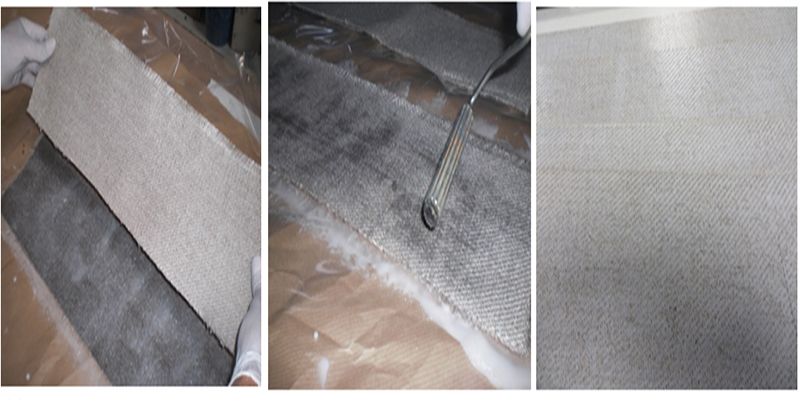Downloads
DOI:
https://doi.org/10.7480/jfde.2016.1-2.1109Keywords:
biofibres, bioresins, fire retardant additives, biocompositesAbstract
Biocomposites are made of natural fibers which are an attractive alternative to conventional synthetic fibers such as glass or carbon fibers not only because their intrinsic properties but also because their contribution to more sustainable materials. However, natural fibres are flammable and the biocomposites need to be protected against fire for safety reasons but also to meet the strictest EU regulations of the transport and construction sectors. Thermosetting composites need high loadings of flame retardant additives to achieve satisfactory results in terms of flammability. However, high levels of flame retardants lead to significant deterioration in mechanical properties. This work explores the possibility of reducing the flammability of flax-biopolyester composites with potential uses in transport and construction sectors through the combination of several novel fire retardant additives which are halogen free and are considered environmentally friendly.
Cone calorimeter tests indicate that proper combinations of FR additives reduced HRR and MARHE values up to a 60% delaying the ignition time with respect to the unfilled material. These results were achieved at concentrations much lower than with traditional solutions. However the addition of dimethyl propyl phosphonate (PMPP) to the resin formulation with ATH and APP failed to demonstrate any significant synergistic effect at reducing the HRR.
How to Cite
Published
Issue
Section
License
Copyright (c) 2016 Javier Sacristan, Nayra Uranga

This work is licensed under a Creative Commons Attribution 4.0 International License.
Authors or their institutions retain copyright to their publications without restrictions.
References
Ahmed El-Sabbagh, S. L. (2014). Composites Part B: Engineering, 62, 12-18.
Aziz S. H., A. M. (2005). Composites Science and Technology,, 1, 525–535.
Babrauskas V., P. W. (1987). Fire and Materials, 11, 31-43.
Babrauskas, V. (1993). Speciman heat fluxes for bench-scale heat release rate testing. Proceedings of Interflam.
Bakhtiyari Saeed, T.-A. L. (2015). Fire and Materials, 39, 1-13.
Bismarck A., M. S. (2005). Plant fibres as reinforcement in green composites. in ‘Natural Fibers, Biopolymers and Biocomposites. Boca Raton: Taylor and Francis.
Camino G., L. M. (1998). Mechanistic study on intumescence in ‘Fire retardancy of polymers: The use of intumescence’ . Cambridge: Royal Society of Chemistry.
Dorez G., T. A.-C. (2013). Polymer Degradation and Stability, 98, 87-95.
Goutianos S., P. T. (2006). Applied Composite Materials, 13, 199-215.
Hapuarachch, P. (2009). eXPRESS Polymer Letters, 3(11), 743-751.
Hull T. Richard, W. A. (2011). Polymer degredation and Stability, 1462-1469.
ISO 5660–1:2002. Reaction-to-fire tests, h. r. (2002). Reaction-to-fire tests, heat release, smoke production and mass loss rate. Part 1: heat release rate (cone calorimeter method). International Standard Organization.
Kandare E, C. A. (2011). Fire and Materials, 35, 3.
Lazko J., L. N. (2013). Polymer Degradation and Stability, 98, 1043-1051.
Levchik S. V., C. G. (1995). Journal of Fire Sciences, 13, 43-58.
Matkó S., T. A. (2005). Polymer Degradation and Stability, 88, 138–145.
Scharte B. (2010). Materials, 3, 4710-4745.
Schartel B., B. U. (2003). Polymer, Volume 44, 20, 6421-6250.
Shen C. Y., S. N. (1969). Journal of the American Chemical Society, 91, 62-67.
Troitzsch J. (2004). Plastics flamability handbook: Principles, regulations, testing and approval. Munich: Hanser Publishers.
Wielagea B., L. T. (1999). Thermochimica Acta, 3337, 169-177.
